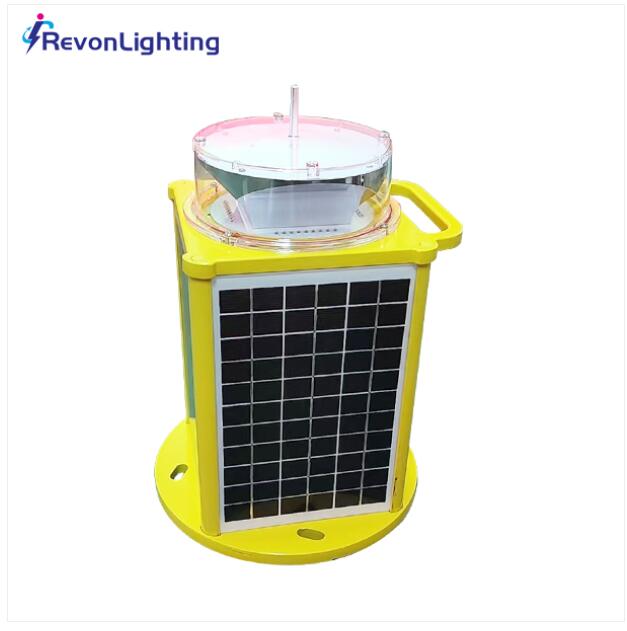Aviation safety is a paramount concern in both civil and military aviation operations. Ensuring the visibility of obstacles such as tall structures, towers, and buildings is crucial to prevent accidents and collisions. Two key components in this safety framework are the solar powered aviation obstruction light and the aircraft warning light system. This article delves into the characteristics, benefits, and advancements of these lighting systems, highlighting their critical role in aviation safety.
Solar Powered Aviation Obstruction Lights
Solar powered aviation obstruction lights are designed to mark obstacles that pose potential hazards to aircraft. These lights are particularly advantageous in remote or off-grid locations where traditional power sources are unavailable or unreliable.
Characteristics
Energy Independence: Solar powered aviation obstruction lights harness solar energy to operate. Equipped with solar panels, these lights convert sunlight into electrical energy, which is stored in batteries for use during nighttime or cloudy conditions.
High Visibility: These lights use high-intensity LEDs to provide bright and clear illumination. The lights are visible from significant distances, ensuring that pilots can easily identify obstacles from afar.
Durability and Weather Resistance: Built to withstand harsh environmental conditions, solar powered aviation obstruction lights are designed with robust materials that can endure extreme temperatures, heavy precipitation, and strong winds.
Autonomous Operation: Once installed, these lights operate autonomously, requiring minimal maintenance. They have built-in sensors to automatically turn on at dusk and off at dawn, ensuring continuous operation without manual intervention.
Benefits
Enhanced Safety: By marking obstacles with highly visible lights, solar powered aviation obstruction lights significantly reduce the risk of aircraft collisions. This is crucial for ensuring the safety of both pilots and passengers.
Cost-Effectiveness: These lights eliminate the need for extensive wiring and electrical infrastructure, reducing installation and operational costs. Their reliance on solar energy also lowers ongoing energy expenses.
Environmental Sustainability: Utilizing renewable solar energy, these lights contribute to reducing carbon emissions and promoting environmentally friendly practices in aviation and construction industries.

Flexibility and Versatility: Solar powered lights can be easily installed in various locations, including remote or inaccessible areas. This flexibility makes them ideal for marking a wide range of obstacles, from communication towers to wind turbines.
Aircraft Warning Light Systems
Aircraft warning light systems are essential for ensuring that pilots can see and avoid obstacles during flight. These systems are mandated by aviation regulatory authorities to enhance navigational safety, especially in low-visibility conditions and at night.
Characteristics
Multiple Light Intensities: Aircraft warning light systems typically incorporate lights of varying intensities, including low, medium, and high. This ensures that obstacles are visible under different lighting conditions and distances.
Color and Flash Patterns: These systems use specific colors and flash patterns to distinguish them from other lights. Red lights are commonly used for nighttime visibility, while white or strobe lights are used during the day.
Synchronization: Advanced aircraft warning light systems can synchronize multiple lights on a single structure to flash in unison. This enhances the visibility of the obstacle and helps pilots identify its shape and size.
Redundancy and Reliability: To ensure continuous operation, these systems often include redundant components and backup power supplies. This reliability is crucial for maintaining safety in all conditions.
Benefits
Improved Navigational Safety: By clearly marking obstacles, aircraft warning light systems help pilots navigate safely, reducing the risk of accidents. This is especially important in densely populated or high-traffic airspace.
Regulatory Compliance: These systems ensure that structures comply with aviation safety regulations set by authorities such as the FAA and ICAO. Compliance helps avoid legal issues and potential fines.
| solar powered aviation obstruction light | aircraft warning light system |
| 13 | 14 |
Versatile Applications: Aircraft warning light systems are used on various structures, including tall buildings, communication towers, bridges, and wind turbines. Their versatility makes them essential for maintaining aviation safety across different industries.
Advanced Monitoring and Control: Modern systems often include remote monitoring and control capabilities. This allows for real-time status updates and the ability to diagnose and address issues promptly.
Technological Advancements
The integration of new technologies has significantly enhanced the performance and reliability of both solar powered aviation obstruction lights and aircraft warning light system.
LED Technology: The shift to LED lighting has improved energy efficiency, brightness, and longevity. LEDs provide consistent illumination while consuming less power and requiring less maintenance.
Smart Systems: The incorporation of smart technology allows for remote monitoring and control. These systems can automatically adjust light intensity based on ambient conditions and provide real-time diagnostics.
Solar and Battery Innovations: Advances in solar panel efficiency and battery storage have enhanced the reliability of solar powered lights. Modern batteries offer longer life cycles and better performance in varying weather conditions.
Integration with Air Traffic Control: Some advanced aircraft warning light systems can integrate with air traffic control systems. This allows for coordinated lighting patterns and improved communication between ground and air operations.
Conclusion
Solar powered aviation obstruction lights and aircraft warning light systems are critical components in ensuring aviation safety. These systems provide reliable, cost-effective, and environmentally sustainable solutions for marking obstacles and enhancing navigational safety. Technological advancements have further improved their efficiency and reliability, making them indispensable in modern aviation. As the aviation industry continues to prioritize safety and sustainability, the role of these lighting systems will only grow in importance, contributing to a safer and more efficient airspace.